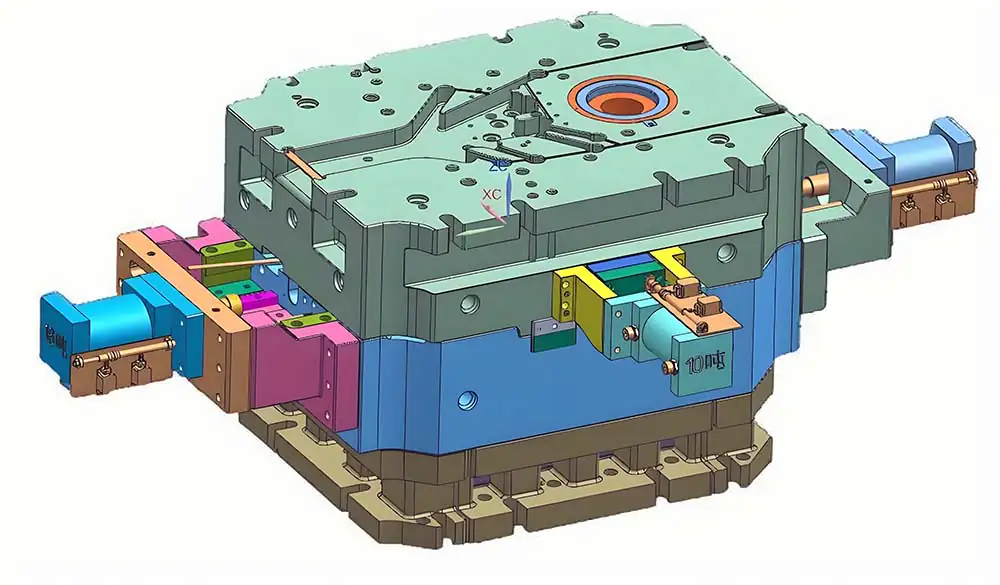Composition and design of aluminum die casting mold
Date: 2024-08-05 Categories: Blog Views: 1919

Aluminum die casting is a commonly used method for mass production of precision castings.aluminumAn efficient manufacturing process for castings. Compared to conventional casting methods, aluminumdie casting moldHigher production efficiency and finer casting dimensions can be achieved. The design and composition of the aluminum die casting die directly affects the quality of the castings, the production cycle and the service life of the die, therefore, it is crucial to design a high-performance aluminum die casting die. Aluminum die casting die refers to the tool used to manufacture aluminum alloy high pressure castings, usually consists of die kernel, die seat, die core, cooling device, sliding device, ejector device and other components. The following is a detailed analysis of aluminum die casting molds:
The main components of aluminum die casting mold
- Mold Cavity
- The die cavity is the core part of an aluminum die casting die and is used to hold the molten aluminum alloy and form the final casting shape. The cavity of an aluminum die casting die is usually made of high-strength alloy steel to cope with the impact of high-pressure aluminum alloys and high-temperature environments. The surface finish of the cavity is critical to the surface quality of the aluminum die casting part, so it is often precision machined and surface treated to improve its durability.
- Gating Systems
- The gate system is the channel through which the molten metal flows into the mold cavity. The gate design must be precise to ensure that the molten aluminum alloy is injected smoothly and evenly into the mold to avoid porosity or defects in the casting. Common types of gates include straight, side, and hot gates, etc. The specific choice is based on the shape of the aluminum die casting and the mold design requirements.
- injection port
- In aluminum die casting, molten aluminum alloy is injected into the mold by a high-pressure injection unit. The design of the injection port is required to be able to withstand high pressure and ensure smooth metal flow. Aluminum die casting mold injection port is generally made of high temperature resistant materials, and its design should ensure that the high speed injection of molten metal does not produce bubbles or flow marks.
- exhaust system
- The exhaust system is used to remove air or gas from the mold cavity during the aluminum die casting process. Poor exhaust will lead to aluminum die casting parts produce porosity, defects and other problems. Therefore, the reasonable design of the exhaust channel and ensure its smooth flow is the key to improve the quality of aluminum die casting parts.
- cooling system
- The cooling system of an aluminum die casting die is used to control the temperature of the die to ensure that the aluminum alloy can solidify quickly in the die to form a high-precision casting. The cooling system usually consists of embedded cooling water tubes or cooling channels to regulate the temperature of the mold through the flow of cooling water. When designing, the cooling system needs to be closely integrated with the structure of the mold cavity to ensure uniform cooling and reduce thermal stress and distortion.
- Mold Frame
- The die frame is the structural support part of the aluminum die casting die, usually made of high strength steel, able to withstand the high temperature and high pressure of aluminum alloy. The design of the mold frame needs to ensure the precise alignment of the components and maintain stability over a long period of time.
- Ejector system
- Ejector systems are used to eject aluminum die castings from the mold after they have cooled and solidified. The ejector system generally consists of ejector pins, guide columns and other components, and its design needs to ensure that the aluminum die casting parts will not be damaged, and at the same time to improve the ejection efficiency. The role of the ejector system has a direct impact on the production efficiency and quality of aluminum die castings.
- sealing system
- The sealing system is used to ensure stable pressure inside the aluminum die casting mold and prevent the molten aluminum alloy from leaking. The sealing of the die directly affects the quality and safety of aluminum die casting, therefore, high quality sealing materials and reasonable sealing design are crucial.
Key Considerations for Aluminum Die Casting Tool Design
- Material Selection
- The choice of material for aluminum die casting molds has an important impact on the durability and productivity of the molds. High-strength alloy steel (e.g. H13 steel) is usually used as the mold material because it has high wear resistance, heat resistance and impact resistance. In addition, in order to improve the service life of the molds, some of the molds are treated with coatings, such as chrome plating, to further enhance the corrosion resistance.
- Mold structure optimization
- Reasonable mold structure can effectively improve the precision and surface quality of aluminum die casting parts. Optimization of the die structure needs to consider the flow characteristics of aluminum alloy, temperature distribution and cooling efficiency and other factors. The use of computer-aided design (CAD) and computer-aided engineering (CAE) tools for mold design and simulation analysis can effectively avoid design defects and optimize the performance of the mold.
- Mold Maintenance and Repair
- The high-temperature, high-pressure working environment of aluminum die casting dies makes them susceptible to wear. Regular cleaning, inspection and replacement of worn parts of the mold is the key to maintain the performance of the mold. Especially when the production cycle is long, the maintenance and repair of the mold is especially important. Regular replacement of wear parts such as cooling lines, exhaust ducts, etc. can prolong the service life of the mold.
- Cooling and Temperature Control
- The temperature control system of the mold must be efficient and precise, and the cooling pipeline design should take into account the heat exchange efficiency to avoid aluminum alloy sticking to the mold or premature damage to the mold due to overheating. Reasonable cooling design helps to shorten the cooling time of the casting, reduce the stress generated during the cooling process, and ensure the precision of aluminum die casting parts.
Aluminum die casting mold classification
Aluminum die casting molds and die casting machines can be divided into different:
Horizontal Cold Chamber Die Casting Die: Die casting machine molds are used to horizontally place the die casting chamber in direct contact with molten aluminum water.
Horizontal hot chamber die casting molds: Die casting machine molds for horizontal placement of the die casting chamber and separation of the molten aluminum water.
Vertical die casting machine mold: die casting machine mold for equipment standing, up and down the mold.
Working Principle
In the process of die casting production, die casting mold is installed on the die casting machine, and die casting machine to form a whole. Through the pressure of the die casting machine, the metal liquid fills the mold cavity under high pressure and high speed, and cools and solidifies under high pressure to obtain die castings. The work of die casting mold is a cyclic cycle work process, including mold synthesis, pouring, compression, mold opening, core extraction, top, extraction, spraying and re-synthesis.
Application Areas
Aluminum die-casting molds are widely used in automotive, electronics, home appliances, aviation and other industries. The following are a few typical application areas:
- automobile industry
- In the automotive industry, aluminum die casting molds are widely used in the manufacture of engine parts, gearbox shells, automotive chassis and other key components. Aluminum alloy's lightweight characteristics and good mechanical properties, make aluminum die casting become the ideal choice in the production of automotive parts.
- Electronic product
- Aluminum die casting molds are also widely used in the production of shells for electronic products, such as cell phone shells, laptop shells and so on. The excellent thermal conductivity and corrosion resistance of aluminum alloy ensures that electronic products will not be affected by high temperature or changes in the external environment during use.
- aerospace
- In the aerospace field, aluminum die casting molds are used to produce high-precision aluminum alloy parts such as aircraft components and spacecraft shells. As aluminum alloy has good strength and corrosion resistance, it is suitable for the high requirements of aerospace equipment.
Aluminum die casting mold advantages and disadvantages
Advantages of Aluminum Die Casting Molds
- High precision and complex shape castings
- Aluminum die casting dies are capable of producing aluminum alloy castings with high precision and consistent dimensions. Through the design of precision molds, the aluminum die casting process can achieve very complex geometries, including requirements for thin walls, complex cavities, and fine surfaces. This makes aluminum die casting widely used in the production of many high-precision parts, especially in the automotive, electronics and home appliance fields.
- Good surface quality
- Due to the precision machining and rapid cooling of aluminum die casting molds, aluminum die casting parts usually have a good surface finish and require little or no secondary machining, which saves on subsequent machining costs. This gives aluminum die casting a great advantage in products with high appearance requirements, and is especially suitable for applications requiring aesthetic surface finishes.
- high productivity
- Aluminum die casting process can achieve high-speed mass production, the mold has a longer service life, and can withstand a higher production cycle. When the mold design is reasonable, a large number of aluminum alloy castings can be produced in a short period of time. Compared with other casting process, aluminum die casting production efficiency is usually higher, suitable for mass production.
- Lightweight and good mechanical properties
- Aluminum alloy has low density, high strength, good corrosion resistance and thermal conductivity, which makes aluminum die casting parts very suitable for the need for lightweight and have a high strength of parts production, such as automotive components, aerospace parts, electronic product shells and so on.
- Reduction of scrap and metal waste
- Aluminum die casting molds can accurately control the amount of metal injected, thus reducing metal waste. In addition, the metal recycling system used in aluminum die casting can also effectively recycle the waste material by re-melting and reusing it, further reducing costs.
Disadvantages of Aluminum Die Casting Molds
- High initial investment
- Aluminum die casting mold design and manufacturing process requires high technical requirements, and the initial investment of the mold is relatively high. The machining accuracy and material selection of the mold directly affects its performance and service life, thus requiring higher manufacturing costs. This may result in a higher initial investment for small batch production projects.
- Limited mold life
- Although aluminum die casting molds are usually made of high-strength alloy steel and other materials, but in the high-pressure, high-temperature environment for a long time operation, the mold will inevitably appear wear and tear, fatigue and deformation problems, affecting the service life of the mold. Especially complex shapes and high precision requirements of aluminum alloy castings, may accelerate the wear and tear of the mold.
- Difficulty in designing complex shaped castings
- Although aluminum die casting is capable of producing complex aluminum alloy castings, in some cases the design and manufacture of the molds is very complex. For example, certain internally complex casting designs may result in molds that are more difficult to machine or even require special design and manufacturing techniques, which can make design and production more difficult.
- Limited applicable materials
- Aluminum die casting molds are mainly used for casting aluminum alloy materials. For casting of other metal materials (such as copper, iron, etc.), aluminum die casting molds are not suitable. In addition, aluminum die casting for some aluminum alloy containing impurities or high melting point of aluminum alloy may face some technical challenges.
- High demands on mold cooling system
- The cooling system in the aluminum die casting mold needs to be designed very reasonably to ensure that the temperature of the mold can be reduced quickly and uniformly in order to avoid thermal stress and deformation caused by excessive temperature difference. Improper design of the cooling system may lead to quality problems of aluminum alloy castings, such as unsmooth surface and inaccurate dimensions.
- High operational requirements
- Aluminum die casting mold operation needs fine control and management, especially in high-speed, large-scale production, mold temperature control, pressure control and metal flow regulation, etc., all need a high level of operation skills. Once improperly operated, it is easy to cause aluminum die casting parts to produce defects, such as porosity, cracks and so on.
In summary, aluminum die casting die is an important tool for manufacturing aluminum alloy die castings, with various classifications, complex working principle and wide application. In the material selection and production process, various factors need to be considered to ensure the performance and service life of the mold.
























